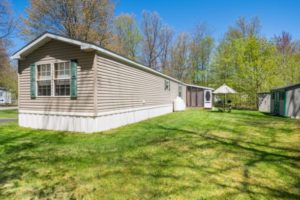A sampling of housing news and resources from around Vermont and beyond
Vermont News
Vermont’s second-largest mobile home park up for sale; residents on the clock

Westbury Park, a 250-lot mobile home park in Colchester, is for sale. That means residents have six weeks to decide if they want to band together and buy it. CVOEO’s Mobile Home Project will be working with the residents as they decide whether they would like to form a coop and buy the park. Mobile home parks in Shelburne and St. George are also for sale. Residents at Shelburne’s Lakeview park are interested in forming a co-op to purchase the park and residents of Sunset Lake Villa Estates and St. George Villa in St. George are trying to purchase those parks after their initial offer was rejected earlier this year. Read the full story about Westbury Park in VTDigger:
https://vtdigger.org/2018/07/24/vermonts-second-largest-mobile-home-park-sale-residents-clock/
Work has started on the Taylor Street transit center, housing complex and recreation path project in Montpelier. The $12.5 million project is a partnership of the city, Downstreet Housing and Development in Barre, and Housing Vermont. It will include 30 affordable and mixed-rate apartments. Read the full story here: https://www.timesargus.com/articles/taylor-street-work-to-begin-aug-2/
National News
 Starting this month, all public housing developments will be smoke-free. A new nationwide policy bans smoking inside public housing and requires smokers to be 25 feet away from the buildings. The U.S. Department of Housing and Urban Development announced the rule in November of 2016 in order to protect people from being exposed to secondhand smoke. The new policy only applies to all lit tobacco products and does not include e-cigarettes. HUD does not mandate designated smoking areas (DSAs), but notes that the use of DSAs could make implementation of the smoke-free policy easier because they demonstrate how far smokers must move away from the building. If a public housing agencies create DSAs, they must be accessible for persons with disabilities, in accordance with ADA, and HUD recommends that they also have appropriate seating and shade. Click here to view HUD’s Smoke Free Guidebook. Read more about the law, as well as public comments and HUD’s response, here:
Starting this month, all public housing developments will be smoke-free. A new nationwide policy bans smoking inside public housing and requires smokers to be 25 feet away from the buildings. The U.S. Department of Housing and Urban Development announced the rule in November of 2016 in order to protect people from being exposed to secondhand smoke. The new policy only applies to all lit tobacco products and does not include e-cigarettes. HUD does not mandate designated smoking areas (DSAs), but notes that the use of DSAs could make implementation of the smoke-free policy easier because they demonstrate how far smokers must move away from the building. If a public housing agencies create DSAs, they must be accessible for persons with disabilities, in accordance with ADA, and HUD recommends that they also have appropriate seating and shade. Click here to view HUD’s Smoke Free Guidebook. Read more about the law, as well as public comments and HUD’s response, here:
https://www.federalregister.gov/documents/2016/12/05/2016-28986/instituting-smoke-free-public-housing
Smithtown, Long Island held its first workforce housing lottery and one person was chosen out of 39 applicants to have the first shot to buy a three-bedroom home for $350,100, which is between $100,000 and $200,000 below the market rate. Town officials implemented a workforce housing policy in 2017 mandating that developers of housing projects with five or more units set aside 10 percent of the units as workforce housing. Purchasers’ and renters’ income cannot exceed 130 percent of area median income, or about $136,550 for a family of three. The nonprofit developer Long Island Housing Partnership conducts about 10 to 15 housing lotteries a year, with some drawing hundreds of applications for a handful of units. Read the full story here: https://www.newsday.com/long-island/suffolk/smithtown-affordable-housing-1.20227297
Good Ideas – YIMBY?
The solution is simple, it really works, but not everyone likes it… It can be hard to build new housing in cities like San Francisco. There’s restrictive zoning that restricts height and neighborhood councils can object to specific projects they don’t like. A group of renters is pushing for a simple solution: Let developers build. Listen to the Planet Money podcast of Yes In My Back Yard here:
Resource of the Week
Homes For All is a production of the Two Rivers-Ottaquechee Regional Commission and CVOEO Fair Housing Project. It provides an introduction on how towns can update their municipal policies to improve housing opportunities. The presentation, recorded in January 2018, is designed for members of local planning commissions, zoning and development review boards, selectboards and other town officials as they seek to meet the housing needs of residents. The training covers 1) Understanding current housing needs and documents, 2) Regulatory Solutions for Affordable Housing, 3) Non- Regulatory Solutions for Affordable Housing, and 4) Resources. Check it out here:
https://www.youtube.com/watch?v=Uh-OhpzDS0U&feature=youtu.be
⇒ Want to see your Vermont housing news featured in this weekly roundup?
Email jhyman [@] cvoeo.org